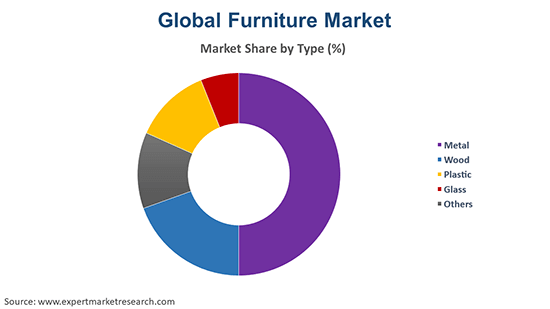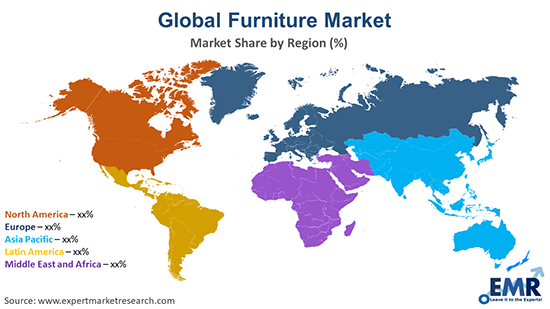
Consumer Insights
Uncover trends and behaviors shaping consumer choices today
Procurement Insights
Optimize your sourcing strategy with key market data
Industry Stats
Stay ahead with the latest trends and market analysis.
Trending Now



The global furniture market was valued at USD 660.35 Billion in 2024 and is anticipated to grow at a CAGR of 4.90% during the forecast period of 2025 to 2034. Rising urbanization, disposable incomes, and demand for multifunctional, eco-friendly, and customized furniture are further propelling the market growth to reach a value of nearly USD 1065.44 Billion by 2034.
Base Year
Historical Year
Forecast Year






Value in USD Billion
2025-2034
Furniture Market Outlook
*this image is indicative*
| Global Furniture Market Report Summary | Description | Value |
| Base Year | USD Billion | 2023 |
| Historical Period | USD Billion | 2018-2024 |
| Forecast Period | USD Billion | 2025-2034 |
| Market Size 2024 | USD Billion | 629.50 |
| Market Size 2034 | USD Billion | 968.22 |
| CAGR 2018-2024 | Percentage | XX% |
| CAGR 2025-2034 | Percentage | 4.9% |
| CAGR 2025-2034 - Market by Region | Asia Pacific | 6.3% |
| CAGR 2025-2034 - Market by Country | India | 7.3% |
| CAGR 2025-2034 - Market by Country | Saudi Arabia | 5.6% |
| CAGR 2025-2034 - Market by Type | Wood | 5.5% |
| CAGR 2025-2034 - Market by End-Use | Residential | 5.4% |
| Market Share by Country 2023 | Australia | 1.5% |
The global furniture market is developing steadily, supported by trends of urbanization, the rise in disposable incomes, and increased home improvement activities. Sustainability and eco-awareness are also a big driver and have consumers seeking recyclable material and modular designs. Among the trends observed are multi-functional furniture for small spaces, smart furniture that integrates with technology, and nature-inspired designs in organic materials like wood and ceramics, thus boosting the furniture market growth.
An example is IKEA's effort to expand the e-commerce platform while making furniture that is eco-friendly and recycled. The company incorporates IoT features such as smart lighting and app-controlled furniture. In addition, government incentives for energy-efficient production methods help IKEA save costs, increase sustainability, and respond to increased demand for green products.
High demand for semi-furnished and fully furnished apartments, mainly driven by the young professional and student demographics who require hassle-free ready-to-move-in living spaces, is bolstering the growth of furniture market. This is highly prominent in fast-growing urban areas of India and China, where people like to opt for apartments with minimal setup requirements.
The demand for stylish yet affordable furniture has become central to business models as consumers seek functional and aesthetically pleasing designs at competitive prices. For instance, modular furniture sales have skyrocketed with increased mobility and smaller living spaces. As the urban population is expected to reach 68% by 2050, according to the UN, furniture companies are focusing on innovative, space-saving designs to meet evolving consumer needs.
Sustainability, integration of smart features, and use of recycled materials are few factors shaping the trends of the furniture market.
Sustainability continues to dominate the global furniture market, where consumers are demanding more and more green, recyclable, and renewable products. The United States Environmental Protection Agency emphasizes that wood is one of the biggest material categories for furniture production, where wood, textiles, and metals are being recycled and recovered. Also, there is the utilization of environmentally friendly materials. For instance, there are FSC-certified woods in the market. More than that, awareness of consumers with regards to the impact on the environment in making traditional furniture has increased consumers' interest in brands that practice eco-friendly materials and processes, shaping the furniture market dynamics and trends.
Smart furniture is one innovation that transformed the market through technological integration in enhancing functionality. The desk with a built-in charging station, the smart bed that adjusts to the user's preference, and the sofa with an embedded speaker are examples of this. Smart furniture is designed for modern consumers who are tech-savvy and want convenience and efficiency in the home office. According to the EPA, innovations in furniture technology also support more sustainable manufacturing processes, helping brands reduce their environmental footprint. Smart features in furniture are also set to continue growing due to the increasing use of technology in daily life.
The increasing trend in demand for multi-functional and minimalist furniture grows as living spaces become smaller in the city. This is because of the optimization of space that can be achieved with furniture that integrates multiple functions like storage and seating, in compact apartments and homes, pushing the furniture demand. For instance, modular couches which double up as beds, or coffee tables that have secret storages. This trend reflects a larger shift toward efficient use of space and resources, which is aligned with the growing desire for sustainable living. According to the EPA, this movement helps reduce material waste and encourages the development of more adaptable and resource-efficient furniture.
The global furniture market has seen a dramatic shift to recycled and reused materials lately. Manufacturers have started infusing their designs with products like reclaimed wood, plastic from recycled items, and upcycled fabrics. The EPA stated that in 2018, more than 9 million tons of furniture were generated in the United States. However, a significant part of it ends up in landfills, while efforts to recycle or recover materials such as wood and metals are increasing. The use of recycled materials mitigates environmental damage and supports the circular economy, whereby products are designed to be reused, refurbished, or recycled instead of being disposed of.
The increasing trend of sustainability is a significant as well as a promising market trend. Key players are attempting to create a circular economy, responsibly source raw materials, and manufacture furniture from recyclable, durable, eco-friendly, and non-toxic materials to improve their ESG and drive carbon neutrality. Such factors are aiding in shaping new trends in the furniture market.
The burgeoning trend of nature-inspired spaces and the growing popularity of neutral pallets and tones, especially in residential spaces, is boosting the demand for furniture made from natural materials like wood, ceramics, and stones, among others.
An example of such a trend is the huge success of Hannun, a Spanish furniture company manufacturing rustic, industrial-style, reclaimed-wood pieces. All this reflects the trend on sustainable, nature-based material use that has become rather popular lately in residential spaces in connection with a rising demand for earthy, neutral shades. Gravity Wave is another successful example: a company specializing in the production of recycled ocean plastics, which, at their turn, blend environmental consciousness and natural textures. It reflects more of the trend of design: introducing natural elements within an interior setting according to the consumer's demand toward sustainability and neutral aesthetics.
Augmented reality is a significant technology in this market that is fast gaining traction through virtual visualization of products, making the customer experience much better. For instance, IKEA introduced the IKEA Place app, allowing users to see how the furniture would fit and look in their own homes using augmented reality, thereby propelling the furniture market dynamics and trends. This not only helps them in decision-making but also decreases return rates. Brands such as Wayfair are incorporating AR into their platforms for smoother shopping and a more interactive experience for customers.
3D printing is increasingly used to streamline, simplify, and reduce costs associated with manufacturing and designing furniture, leading to new furniture market opportunities. It also enables designers to use innovative materials and develop furniture with innovative geometrics, excellent ergonomics, and customised shape, size, and colour. In addition, advanced technologies like IoT, AI, AR, and VR, among others, are expected to support the market development in the coming years.
The increasing use of innovative materials such as cork, mycelium, and linoleum in furniture design and manufacturing is anticipated to fuel the market growth in the forecast period.

Read more about this report - REQUEST FREE SAMPLE COPY IN PDF
“Furniture Market Report and Forecast 2025-2034” offers a detailed analysis of the market based on the following segments:
Market Breakup by Type
Market Breakup by End Use
Market Breakup by Distribution Channel
Market Breakup by Region
By Type Analysis
As per furniture market analysis, metal furniture is valued for durability and is in high demand in industrial and outdoor applications. Wood remains the leading material, valued for aesthetic appeal and versatility in residential and commercial settings. Plastic furniture is increasingly in demand for its affordability and lightness, particularly in low-budget markets. Glass furniture adds a touch of modernity to interiors and appeals to high-end consumers. Other materials, such as rattan and bamboo, are gaining popularity among eco-conscious buyers, which is aligned with the sustainability trend and drives demand worldwide.
End Use Insights
Residential demand is growing owing to the increasing urbanization and more homeowners, who require functional yet fashionable furniture for their homes. Commercial demand is growing because of growing office space, hotels, and retail, where emphasis is placed on ergonomic and durable designs. Home office furniture has been enhanced through remote work, while hospitality recovery from the pandemic further increases demand for luxury as well as functional pieces in business and leisure travelers' preferences.
Market Analysis by Distribution Channel
As per furniture industry analysis, the majority of furniture sales are done through offline channels, which include specialty stores and furniture showrooms, giving consumers the opportunity to experience the product before purchasing. Convenience, varied products, and augmented reality capabilities for virtual visualization are increasing online market share. Large e-commerce companies are introducing easy return policies and customization options for buyers. Omnichannel strategies are reshaping furniture shopping, increasing market access by several fold.

Read more about this report - REQUEST FREE SAMPLE COPY IN PDF
North America Furniture Market Opportunities
Sustainability initiatives are driving the furniture market in North America. The United States Environmental Protection Agency is promoting eco-friendly practices. There is growth in smart furniture demand, with 37% of Americans preferring technology-integrated designs. Government housing programs, such as the U.S. HUD's affordable housing initiatives, are also stimulating furniture sales. The strong real estate market in Canada also contributes to this market, with 28% of new homes being semi-furnished. Tax incentives for green building materials further boost market growth.
| CAGR 2025-2034 - Market by | Country |
| India | 7.3% |
| Saudi Arabia | 5.6% |
| Mexico | 4.6% |
| UK | 4.5% |
| USA | 4.0% |
| Canada | XX% |
| France | XX% |
| China | XX% |
| Japan | 3.8% |
| Australia | XX% |
| Brazil | XX% |
| Germany | 3.6% |
| Italy | 3.1% |
Asia Pacific Furniture Market Trends
The Asia Pacific furniture market is growing due to rapid urbanization, mainly in China and India. In India, the number of houses under PMAY (Pradhan Mantri Awas Yojana) to be constructed by 2024 is approximately 20 million, which will add to the demand for furniture. In China, over 60% of sales occur through e-commerce in furniture. Rising middle-class income in the region and interest in multi-functional furniture drives innovation. Modular furniture is gaining acceptance in Japan, where compact living spaces have become the norm.
Europe Furniture Market Dynamics
Stringent EU environmental regulations promote circular economy models in Europe's furniture industry. Germany dominates luxury furniture with exports of EUR 9 billion in 2023. Horizon Europe funds innovation in sustainable materials, which promote biodegradable materials. Scandinavian countries are dominant in minimalist design trends. The Artisan Support Policy in Italy strengthens traditional craftsmanship. Brexit-related trade readjustments offer opportunities for local production within the UK to focus on supply chain resilience.
Middle East and Africa Furniture Market Drivers
The Middle East furniture industry is augmenting with high-end demand from Dubai Expo 2020's infrastructure projects. In Africa, the African Union's Agenda 2063 focuses on urbanization, and housing developments boost mid-range furniture sales. Saudi Arabia's Vision 2030 plans $500 billion in smart city projects, which increases modular furniture demand. Government investments in local manufacturing, such as Nigeria's Industrial Revolution Plan, aim to reduce imports, fostering domestic furniture production and creating employment opportunities.
Latin America Furniture Market Insights
Housing policies, such as Brazil's Minha Casa Minha Vida, which has provided 5 million families with affordable homes since 2009, fuel the Latin America Market for furniture. The nearshoring trend in Mexico increases exports, with furniture production rising by 12% in 2023. Regional sustainability programs, such as Colombia's Green Growth Policy, foster environmentally friendly furniture production. Argentina's growing urban population of 91% in 2024 increases demand for modern designs, while e-commerce adoption drives furniture sales across the region.
Furniture market players are currently differentiating through sustainability, innovative designs, smart technology integration, and customization options. Companies like IKEA emphasize recyclable materials and modular designs, whereas startups are using 3D printing for efficiency. Integration of e-commerce and virtual tools like AR/VR are also helping to enhance the customer experience, thereby demonstrating flexibility toward changing consumer preferences and regional demands. Premium furniture companies, on the other hand, focus on craftsmanship and high-end luxury products that appeal to premium markets.
Steelcase Inc. is a prominent furniture company, based in Michigan, the United States. It was established in 1912, and it is involved in designing and manufacturing furniture for commercial purposes. Its products are sold in more than 770 locations around the world.
Haworth Inc. is one of the largest office furniture manufacturers in the world. It was founded in 1948 and is headquartered in Michigan, the United States. With a presence in over 150 countries, the company aims to develop high-quality furniture that can enhance the productivity of employees.
Kinnarps AB, established in 1942, is a company that designs, manufactures, and markets furniture for use in schools, hospitals, and offices, among others. Its furniture pieces are known for their quality, functionality, ergonomics, and aesthetics.
*Please note that this is only a partial list; the complete list of key players is available in the full report. Additionally, the list of key players can be customized to better suit your needs.*
Other furniture market players include Poltrona Frau S.p.a., VITRA INTERNATIONAL AG, Knoll®, Inc., NOWY STYL Sp. z o.o., Design Holding Group, Nitori Co., Ltd., Hooker Furnishings, Natuzzi S.p.A., and Ethan Allen Global, Inc.
Global furniture market startups aim to serve changing consumer preferences through unique and customized solutions. They apply technology to enhance the purchasing experience on the internet, create smart furniture, and offer a sustainable solution. For instance, MYCS from Germany offers customized furniture as per the customer's choice. In India, Pepperfry is an online marketplace which provides a wide variety of home decor options through friendly interfaces. These startups use funding to innovate, expand product lines, and disrupt traditional furniture retail models.
Based in Spain, Gravity Wave has created sustainable furniture from recycled ocean plastic by turning the waste into more versatile objects like tables and benches. In their approach, the firm does not only target environmental concerns but also boosts a circular economy through minimal wastes.
Fegno is an Indian startup that has made the online shopping experience better for furniture sellers with a complete e-commerce platform. Fegno's platform optimizes product management and increases visibility for sellers, making it easier for consumers to discover and purchase furniture.
*While we strive to always give you current and accurate information, the numbers depicted on the website are indicative and may differ from the actual numbers in the main report. At Expert Market Research, we aim to bring you the latest insights and trends in the market. Using our analyses and forecasts, stakeholders can understand the market dynamics, navigate challenges, and capitalize on opportunities to make data-driven strategic decisions.*
Get in touch with us for a customized solution tailored to your unique requirements and save upto 35%!
In 2024, the market reached an approximate volume of 660.35 Billion.
The furniture industry is assessed to grow at a CAGR of 4.90% between 2025 and 2034.
The market is estimated to witness healthy growth in the forecast period of 2025-2034 to reach around 1065.44 Billion by 2034.
The major market drivers are the rising demand for furniture made from natural and sustainable materials and the growing trend of home décor.
The key trends aiding the market growth are the increasing use of 3D printing to manufacture furniture, the rising demand for wood furniture, and the development of new furniture materials.
The major regions in the market are North America, Latin America, the Middle East and Africa, Europe, and the Asia Pacific.
The significant distribution channels in the market are online and offline.
The major players in the market are Steelcase Inc., Haworth Inc., Kinnarps AB, Poltrona Frau S.p.a., VITRA INTERNATIONAL AG, Knoll®, Inc., NOWY STYL Sp. z o.o., Design Holding Group, Nitori Co., Ltd., Hooker Furnishings, Natuzzi S.p.A., and Ethan Allen Global, Inc.
Explore our key highlights of the report and gain a concise overview of key findings, trends, and actionable insights that will empower your strategic decisions.
| REPORT FEATURES | DETAILS |
| Base Year | 2024 |
| Historical Period | 2018-2024 |
| Forecast Period | 2025-2034 |
| Scope of the Report |
Historical and Forecast Trends, Industry Drivers and Constraints, Historical and Forecast Market Analysis by Segment:
|
| Breakup by Type |
|
| Breakup by End-Use |
|
| Breakup by Distribution Channel |
|
| Breakup by Region |
|
| Market Dynamics |
|
| Competitive Landscape |
|
| Companies Covered |
|
Datasheet
One User
USD 2,499
USD 2,249
tax inclusive*
Single User License
One User
USD 3,999
USD 3,599
tax inclusive*
Five User License
Five User
USD 4,999
USD 4,249
tax inclusive*
Corporate License
Unlimited Users
USD 5,999
USD 5,099
tax inclusive*
*Please note that the prices mentioned below are starting prices for each bundle type. Kindly contact our team for further details.*
Flash Bundle
Small Business Bundle
Growth Bundle
Enterprise Bundle
*Please note that the prices mentioned below are starting prices for each bundle type. Kindly contact our team for further details.*
Flash Bundle
Number of Reports: 3
20%
tax inclusive*
Small Business Bundle
Number of Reports: 5
25%
tax inclusive*
Growth Bundle
Number of Reports: 8
30%
tax inclusive*
Enterprise Bundle
Number of Reports: 10
35%
tax inclusive*
How To Order
Our step-by-step guide will help you select, purchase, and access your reports swiftly, ensuring you get the information that drives your decisions, right when you need it.

Select License Type
Choose the right license for your needs and access rights.

Click on ‘Buy Now’
Add the report to your cart with one click and proceed to register.

Select Mode of Payment
Choose a payment option for a secure checkout. You will be redirected accordingly.
Gain insights to stay ahead and seize opportunities.

Get insights & trends for a competitive edge.

Track prices with detailed trend reports.

Analyse trade data for supply chain insights.

Leverage cost reports for smart savings

Enhance supply chain with partnerships.

Connect For More Information
Our expert team of analysts will offer full support and resolve any queries regarding the report, before and after the purchase.
Our expert team of analysts will offer full support and resolve any queries regarding the report, before and after the purchase.
We employ meticulous research methods, blending advanced analytics and expert insights to deliver accurate, actionable industry intelligence, staying ahead of competitors.
Our skilled analysts offer unparalleled competitive advantage with detailed insights on current and emerging markets, ensuring your strategic edge.
We offer an in-depth yet simplified presentation of industry insights and analysis to meet your specific requirements effectively.



Australia
63 Fiona Drive, Tamworth, NSW
+61-448-061-727
India
C130 Sector 2 Noida, Uttar Pradesh 201301
+91-723-689-1189
Philippines
40th Floor, PBCom Tower, 6795 Ayala Avenue Cor V.A Rufino St. Makati City,1226.
+63-287-899-028, +63-967-048-3306
United Kingdom
6 Gardner Place, Becketts Close, Feltham TW14 0BX, Greater London
+44-753-713-2163
United States
30 North Gould Street, Sheridan, WY 82801
+1-415-325-5166
Vietnam
193/26/4 St.no.6, Ward Binh Hung Hoa, Binh Tan District, Ho Chi Minh City
+84-865-399-124
United States (Head Office)
30 North Gould Street, Sheridan, WY 82801
+1-415-325-5166
Australia
63 Fiona Drive, Tamworth, NSW
+61-448-061-727
India
C130 Sector 2 Noida, Uttar Pradesh 201301
+91-723-689-1189
Philippines
40th Floor, PBCom Tower, 6795 Ayala Avenue Cor V.A Rufino St. Makati City, 1226.
+63-287-899-028, +63-967-048-3306
United Kingdom
6 Gardner Place, Becketts Close, Feltham TW14 0BX, Greater London
+44-753-713-2163
Vietnam
193/26/4 St.no.6, Ward Binh Hung Hoa, Binh Tan District, Ho Chi Minh City
+84-865-399-124
Share